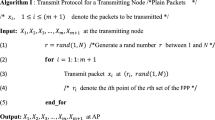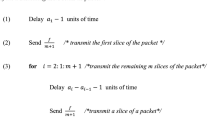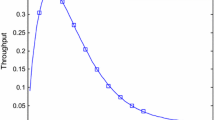Abstract
Random Access techniques are many, most of which are designed for a limited number of mobile nodes. However, in a 5G Internet of Things environment, the design of random access must accommodate a very large number of devices which are heterogeneous in nature, and packets are in general short and come in a variety of lengths. Variable lengths of short packets may waste bandwidth if each packet transmits at the beginning of a time slot. In this paper, packet squeezing allows for a packet to make a selection between aligning to the beginning and aligning to the ending of a time slot. Two or more nodes transmitting at the same time slot may not result in a collision if two conditions are met simultaneously. First, one node selects an alignment mode different from that of the remaining nodes. Secondly, the sum of the time durations of two “representative” packets is shorter than the duration of a time slot. The performance analysis demonstrates that the throughput gain due to the packet squeezing is significant. The gain of packet squeezing can be enhanced by time slot management, where a transmitting node randomly selects a set of points of Finite Projective Plane and transmits at the time slots corresponding to the points of the chosen set. Due to the rather uniform distribution of the transmitting nodes and fewer empty time slots, the gain of packet squeezing is further improved for the entire frame. Based on the simulation results and analysis, we have observed that the time slot management extends the range of packet arrival rate of peak throughput for packet squeezing. Lastly, we compare and contrast the combining of packet squeezing and time slot management with well-known random access protocols of IoT such as slotted ALOHA and NOMA, and simulate real systems to verify the results of performance analysis.

















Similar content being viewed by others
References
Al-Fuqaha, A., et al. (2015). Internet of Things: A survey on enabling technologies, protocols, and applications. IEEE Communications Surveys and Tutorials, 17(4), 2347–2376.
Osseiran, et al. (2014). Scenarios for 5G Mobile and Wireless Communications: the Vision of the METIS project. IEEE Communications Magazine, 52(5), 26–35.
Shafi, M., et al. (2017). 5G: A tutorial overview of standards, trials, challenges, deployment, and practice. IEEE Journal on Selected Areas in Communications, 35(6), 1201–1221.
Dawy, Z., et al. (2017). Toward massive machine type cellular communications. IEEE Wireless Communications, 24(1), 120–128.
Ikpehai, A., et al. (2019). Low-power wide area network technologies for Internet-of-Things: A comparative review. IEEE Internet of Things Journal, 6(2).
Chen, H., et al. (2020). Age-of-Information dependent random access for massive IoT networks. INFOCOM 2020.
“Study on Scenarios and Requirements for Next Generation Access Technologies,” 3GPP, Sophia Antipolis, France, Rep. TR 38.913 V14.3.0, Jun. 2017.
Wang, Y., et al. (2017). A primer on 3GPP narrowband Internet of Things. IEEE Communications. Magazine, 55(3), 117–123.
Navarro-Ortiz, J., et al. (2018). Integration of LoRaWAN and 4G/5G for the industrial Internet of Things. IEEE Communications Magazine, 56(2), 60–67.
Abramson, N. (1970). The ALOHA system: Another alternative for computer communications. In Proceedings of 1970 fall joint computer conference (Vol. 37, pp. 281–285).
Abramson, N. (1977). The throughput of packet broadcasting channels. IEEE Transactions on Communications, 25(1), 117–128.
Tegos, S. A., et al. (2020). Slotted ALOHA with NOMA for the next generation IoT. IEEE Transactions on Communications, 68(10), 6289–6301.
Lin, H., Kim, K. S., & Shin, W. S. (2020). Interference-aware opportunistic random access in dense IoT network. IEEE Access, 8, 93472–93486.
Casini, E., Gaudenzi, R. D., & Herrero, O. D. R. (2007). Contention Resolution Diversity Slotted Aloha (CRDSA): An enhanced random access scheme for satellite access packet networks. IEEE Transactions on Wireless Communications, 6(4), 1408–1419.
Liva, G. (2011). Graph-based analysis and optimization of contention resolution diversity slotted ALOHA. IEEE Transactions on Communications, 59(2), 477–487.
Narayanan, K. R., & Pfister, H. D. (2012). Iterative collision resolution for slotted ALOHA: An Optimal Uncoordinated Transmission Policy. In Proceedings of 2012 ISTC, Gothenburg (pp. 136–139).
Byers, J., Luby, M., Mitzenmacher, M., & Rege, A. (1998). A digital fountain approach to reliable distribution of bulk data. In Proceedings of 1998, ACM SIGCOMM., Vancouver (pp. 56–67).
Paolini, E., Stefanovi, C., Liva, G., & Popovski, P. (2015). Coded random access: Applying codes on graphs to design random access protocol. IEEE Communications Magazine, 144–150.
Mengali, A., Gaudenzi, R. D., & Stefanovi, C. (2018). On the modeling and performance assessment of random access with SIC. IEEE Journal on Selected Areas in Communications, 36(2), 292–303.
Moon, S., et al. (2018). SARA: Sparse code multiple access-applied random access for IoT devices. IEEE Internet of Things Journal, 5(4).
Diamantoulakis, P. D., Pappi, K. N., Ding, Z., & Karagiannidis, G. K. ( 2016). Wireless-powered communications with non-orthogonal multiple access. IEEE Transactions on Wireless Communications, 15(12), 8422–8436.
Ding, Z., Lei, X., Karagiannidis, G. K., Schober, R., Yuan, J., & Bhargava, V. K. ( 2017). A survey on non-orthogonal multiple access for 5G networks: research challenges and future trends. IEEE Journal on Selected Areas in Communications, 35(10), 2181–2195.
Xiao, L., Li, Y., Dai, C., Dai, H., & Poor, H. V. (2018). Reinforcement learning based NOMA power allocation in the presence of smart jamming. IEEE Transactions on Vehicular Technology, 67(4), 3377–3389.
Choi, J. (2018). Layered non-orthogonal random access with SIC and transmit diversity for reliable transmissions. IEEE Transactions on Communications, 66(3), 1262–1272.
Yuan, Y., Yuan, Z., & Tan, L. (2020). 5G non-orthogonal multiple access study in 3GPP. IEEE Communications Magazine, 58(7), 90–96.
Abbas, R., Shirvanimoghaddam, M., Li, Y., & Vucetic, B. (2019). A novel analytical framework for massive grant-free NOMA. IEEE Transactions on Communications, 67(3), 2436–2449.
Woo, T. K. (2019). FRAM: Framed ALOHA for 5G super real-time multimedia random access with packet slicing. Wireless Personal Communications, 106, 1253–1073.
Hughes, D. R., & Piper, F. (1973). Projective plane. Berlin: Springer.
Hall, M., Jr. (1986). Combinatorial theory (2nd ed.). New York, NY: Wiley.
Nakajima, A. (1992). Using a finite projective plane with a duality for decentralized consensus protocols. In Proceedings of the 12th international conference on distributed computing systems (pp. 665–672).
Czerwinski, T., & Oakden, D. (1992). The translation planes of order twenty-five. Journal of Combinatorics, 193–217.
Dempwolff, U. (1994). Translation planes of order 27’, Des. Codes and Crypt, pp. 105–121.
Author information
Authors and Affiliations
Corresponding author
Additional information
Publisher's Note
Springer Nature remains neutral with regard to jurisdictional claims in published maps and institutional affiliations.
Rights and permissions
About this article
Cite this article
Woo, TK. Packet Squeezing of Random Access with 5G Real-Time Services for Internet of Things. Wireless Pers Commun 118, 1365–1392 (2021). https://doi.org/10.1007/s11277-021-08080-4
Accepted:
Published:
Issue Date:
DOI: https://doi.org/10.1007/s11277-021-08080-4




